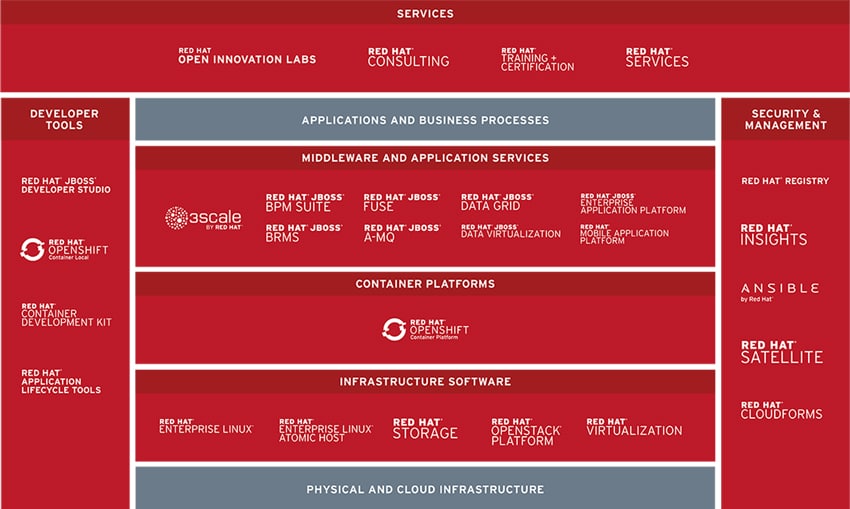 Today Red Hat announced the latest version of its cloud Infrastructure-as-a-Service (IaaS) solution, Red Hat OpenStack Platform 10. The latest version is based off of OpenStack’s ‘Newton’ release. The new version is filled with new features aimed at enhancing performance and security, increasing scalability, improving orchestration, and easing management. On top of that, Red Hat is also introducing a new software life cycle, with optional support up to 5 years.
Today Red Hat announced the latest version of its cloud Infrastructure-as-a-Service (IaaS) solution, Red Hat OpenStack Platform 10. The latest version is based off of OpenStack’s ‘Newton’ release. The new version is filled with new features aimed at enhancing performance and security, increasing scalability, improving orchestration, and easing management. On top of that, Red Hat is also introducing a new software life cycle, with optional support up to 5 years.
Today Red Hat announced the latest version of its cloud Infrastructure-as-a-Service (IaaS) solution, Red Hat OpenStack Platform 10. The latest version is based off of OpenStack’s ‘Newton’ release. The new version is filled with new features aimed at enhancing performance and security, increasing scalability, improving orchestration, and easing management. On top of that, Red Hat is also introducing a new software life cycle, with optional support up to 5 years.

The latest version of Red Hat’s OpenStack platform is built off of Red Hat Enterprise Linux. The new platform is integrated with the OpenStack community code, and, according to Red Hat, can provide the agility to scale and more quickly meet customer demand without compromising availability, performance, or IT security requirements. Red Hat is also including its hybrid cloud management and monitoring platform, Red Hat CloudForms. Cloudforms will help users by monitoring infrastructure components and workloads. And Red Hat will also provide 64TB of Ceph Storage with the platform.
New enhancements include:
- A more streamlined user experience driven by an easier-to-use graphical user interface (GUI) reduces the complexities of installation and management. Designed for production use, the Red Hat OpenStack Platform director GUI provides several newly integrated functions, such as automatic upgrades and updates (including Ceph), advanced networking configuration, high availability, and the option to deploy file sharing via the Manila service, using the integrated drivers available from NetApp and Red Hat Ceph Storage.
- Improved flexibility for greater scalability through the introduction of customizable services and administration roles using Red Hat OpenStack Platform director. Cloud operators are now able to control their OpenStack environment at a more granular level by customizing OpenStack services to run and scale independently of each other. This offers greater flexibility when deploying services to match individual organizations’ unique workload requirements.
- Greater data assurance through new security-related enhancements, such as improved high availability (HA) for large-scale deployments. Additionally, optional object storage encryption and ephemeral security tokens improve security measures and lower risk of data access due to theft.
- Improved performance for network-intensive workloads through the new data plane developer kit (DPDK) component of Open vSwitch, and single-root input/output virtualization (SR-IOV), results in network performance that is comparable to bare metal. Additionally, network routing is now more flexible and faster, allowing customers to choose between centralized routing or distributed routing (DVR).
- A new “ready state” hardware certification program, based on OpenStack Ironic. While Red Hat already supports certified hardware plug-ins for several OpenStack components, the new program is designed to expand the ecosystem of hardware options for automated bare-metal configuration. Dell EMC is the first Red Hat partner to be certified for Red Hat OpenStack Platform 10 ready-state, with several more coming soon.
- Distributed continuous integration (DCI) to key partners, such as Dell EMC, NEC, and Rackspace. This collaborative approach to testing can help partners more effectively prepare for new Red Hat OpenStack Platform releases, and provide customers with greater stability and higher quality cloud solutions that have been tested many times over with their uniquely integrated cloud system than previously offered.
The Red Hat OpenStack Platform 10 comes with two life cycle support options. Customers can choose a long life version with a 3-year product lifecycle and optional two additional years of extended life cycle (ELS) support available for purchase. Or they can choose to go with rolling upgrades to follow the latest releases of every new version of Red Hat OpenStack Platform.
Long Life versions of Red Hat OpenStack Platform will be offered every third release, starting with Red Hat OpenStack Platform 10. Versions in between will include one year of life cycle support.
Sign up for the StorageReview newsletter
